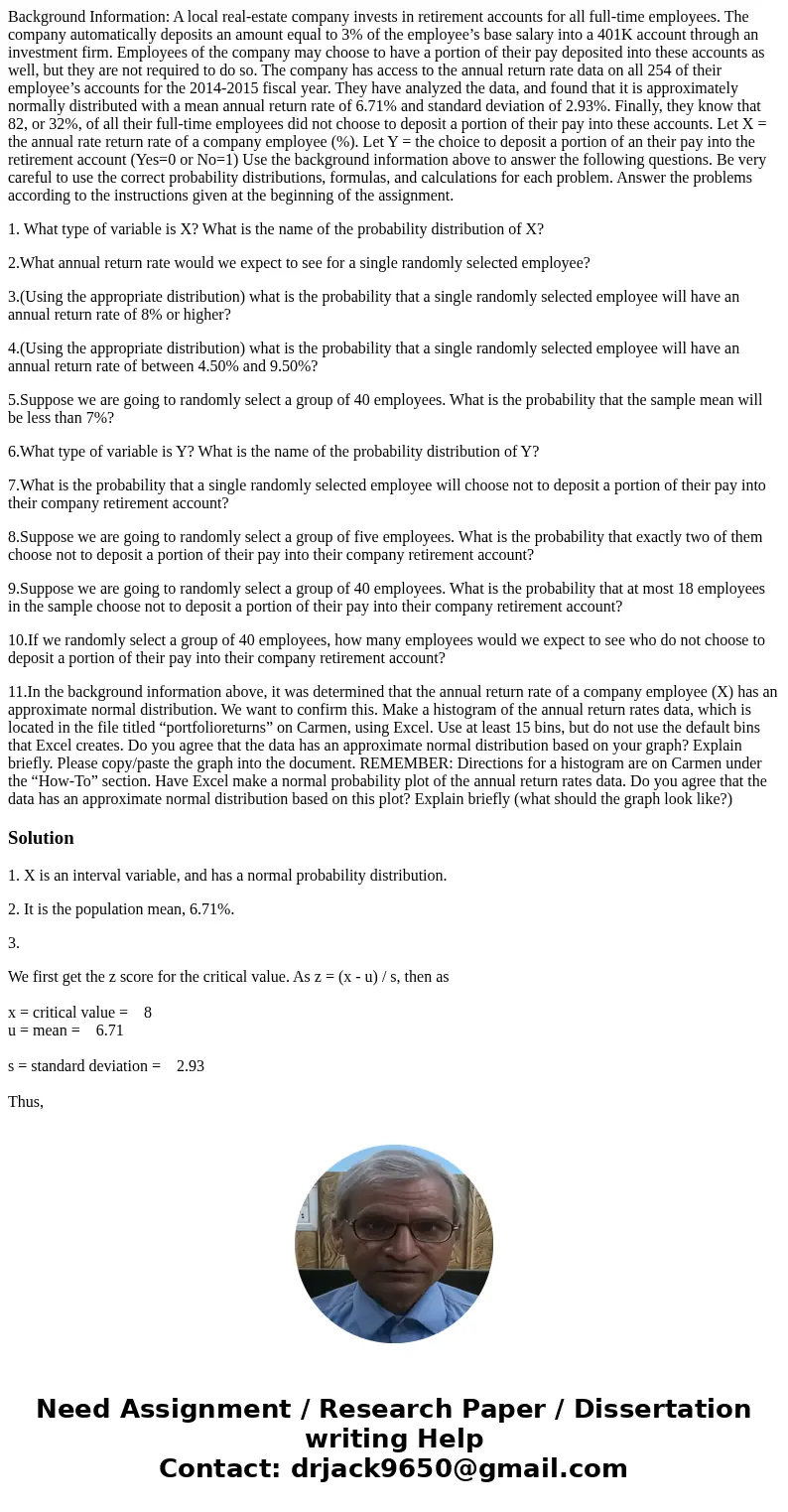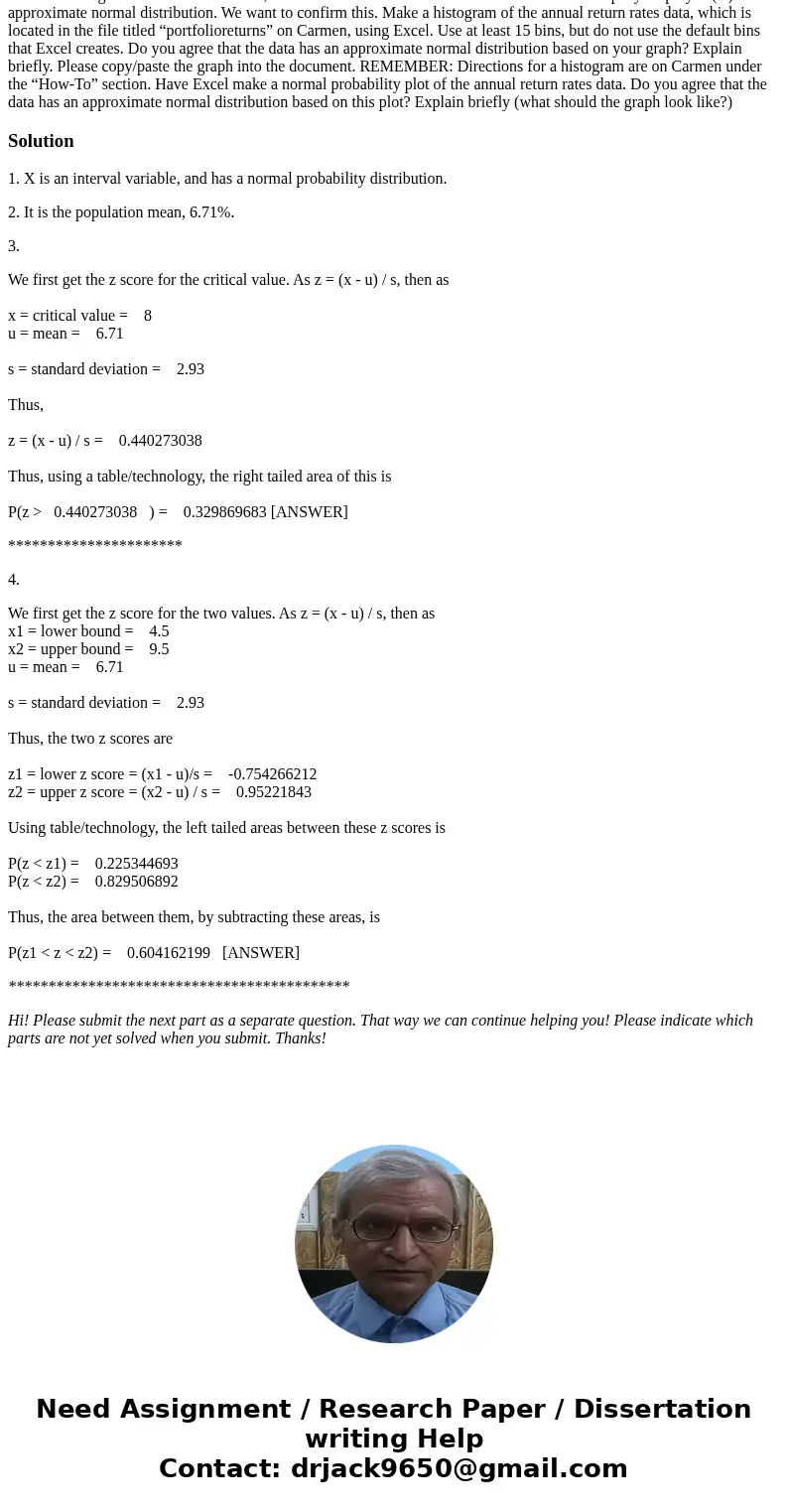Background Information A local realestate company invests in
Background Information: A local real-estate company invests in retirement accounts for all full-time employees. The company automatically deposits an amount equal to 3% of the employee’s base salary into a 401K account through an investment firm. Employees of the company may choose to have a portion of their pay deposited into these accounts as well, but they are not required to do so. The company has access to the annual return rate data on all 254 of their employee’s accounts for the 2014-2015 fiscal year. They have analyzed the data, and found that it is approximately normally distributed with a mean annual return rate of 6.71% and standard deviation of 2.93%. Finally, they know that 82, or 32%, of all their full-time employees did not choose to deposit a portion of their pay into these accounts. Let X = the annual rate return rate of a company employee (%). Let Y = the choice to deposit a portion of an their pay into the retirement account (Yes=0 or No=1) Use the background information above to answer the following questions. Be very careful to use the correct probability distributions, formulas, and calculations for each problem. Answer the problems according to the instructions given at the beginning of the assignment.
1. What type of variable is X? What is the name of the probability distribution of X?
2.What annual return rate would we expect to see for a single randomly selected employee?
3.(Using the appropriate distribution) what is the probability that a single randomly selected employee will have an annual return rate of 8% or higher?
4.(Using the appropriate distribution) what is the probability that a single randomly selected employee will have an annual return rate of between 4.50% and 9.50%?
5.Suppose we are going to randomly select a group of 40 employees. What is the probability that the sample mean will be less than 7%?
6.What type of variable is Y? What is the name of the probability distribution of Y?
7.What is the probability that a single randomly selected employee will choose not to deposit a portion of their pay into their company retirement account?
8.Suppose we are going to randomly select a group of five employees. What is the probability that exactly two of them choose not to deposit a portion of their pay into their company retirement account?
9.Suppose we are going to randomly select a group of 40 employees. What is the probability that at most 18 employees in the sample choose not to deposit a portion of their pay into their company retirement account?
10.If we randomly select a group of 40 employees, how many employees would we expect to see who do not choose to deposit a portion of their pay into their company retirement account?
11.In the background information above, it was determined that the annual return rate of a company employee (X) has an approximate normal distribution. We want to confirm this. Make a histogram of the annual return rates data, which is located in the file titled “portfolioreturns” on Carmen, using Excel. Use at least 15 bins, but do not use the default bins that Excel creates. Do you agree that the data has an approximate normal distribution based on your graph? Explain briefly. Please copy/paste the graph into the document. REMEMBER: Directions for a histogram are on Carmen under the “How-To” section. Have Excel make a normal probability plot of the annual return rates data. Do you agree that the data has an approximate normal distribution based on this plot? Explain briefly (what should the graph look like?)
Solution
1. X is an interval variable, and has a normal probability distribution.
2. It is the population mean, 6.71%.
3.
We first get the z score for the critical value. As z = (x - u) / s, then as
x = critical value = 8
u = mean = 6.71
s = standard deviation = 2.93
Thus,
z = (x - u) / s = 0.440273038
Thus, using a table/technology, the right tailed area of this is
P(z > 0.440273038 ) = 0.329869683 [ANSWER]
**********************
4.
We first get the z score for the two values. As z = (x - u) / s, then as
x1 = lower bound = 4.5
x2 = upper bound = 9.5
u = mean = 6.71
s = standard deviation = 2.93
Thus, the two z scores are
z1 = lower z score = (x1 - u)/s = -0.754266212
z2 = upper z score = (x2 - u) / s = 0.95221843
Using table/technology, the left tailed areas between these z scores is
P(z < z1) = 0.225344693
P(z < z2) = 0.829506892
Thus, the area between them, by subtracting these areas, is
P(z1 < z < z2) = 0.604162199 [ANSWER]
*******************************************
Hi! Please submit the next part as a separate question. That way we can continue helping you! Please indicate which parts are not yet solved when you submit. Thanks!


 Homework Sourse
Homework Sourse